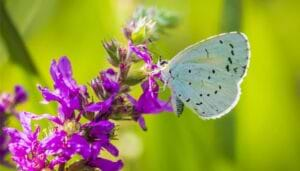
The sight of brightly coloured butterflies fluttering around our garden can be quite uplifting. When our favourite garden visitors return, spring is in full swing and brighter summer days aren’t far around the corner. Delicate creatures, butterflies enhance our garden with their colour and calming aura.
According to a wildlife survey, 2019 was a fantastic year for butterflies. The annual Big Butterfly Count revealed it had been the best summer in a decade in terms of the variety of species and the number of butterflies spotted across Britain.
Brimstone

© Stefan / Adobe Stock
As one of the first to be seen each year, the brimstone butterfly can be spotted all year round, as they winter in the UK, but their peak times are April and May - although there are still plenty around in July and August.
The caterpillars feed on buckthorn and alder buckthorn, while the adults prefer purple thistle flowers. This limits the species' habitat to where these plants grow. The female brimstone's colouring enables it to blend invisibly into the alder leaves, where it lays its eggs. It's found in parts of England, Ireland and Wales, with a few sightings in Scotland.
In butterfly terms, the brimstone has a very long lifespan of around 14 months, from the egg until it dies in old age. Many species die after mating, but the brimstone reaches maturity over winter and is one of the first species to reappear in the spring.
Holly blue

© Sander Meertins / Adobe Stock
A beautiful bright hue, the female holly blue is distinguished by the black edges around its wings. It is more widespread in southern England, although in recent years it has spread northwards, with a colony being found in Edinburgh.
It appears quite early in spring and lives mainly in woodlands and gardens. The caterpillars eat flower buds and the berries from holly, ivy, spindle and dogwood plants. Adult butterflies feed on honeydew - a liquid which aphids secrete on to plants.
The lifespan of the holly blue is sadly quite short. After hibernating all winter, once the pupae hatches in April, it lives only until June.
A second cycle begins with the egg growing in the pupae stage for only two weeks. It hatches in late July and lives for a few weeks. Eggs from the second generation create the pupae that hibernate all winter.
Peacock

© Fiona / Adobe Stock
The peacock butterfly is another familiar species in Britain. It has spread across the country, up to the far north of Scotland. Its dramatic appearance features reddish-purple wings with a spotted pattern that resembles a pair of eyes.
Its unusual pattern isn't just for effect - it is used to scare predators, including birds. When the peacock butterfly flashes its wings open, the eye-like markings are accompanied by a hissing sound as it rubs its wings together to deter mice and bats.
As one of Britain's largest butterflies, the female has a 2.7-inch wingspan and the male has a 2.4-inch wingspan. Caterpillars eat nettles and the butterflies eat buddleia and other garden plants. The male is territorial and after the mating season, it chases away other butterflies from its patch.
With a long lifespan of around 11 months, peacock butterflies feed a lot in late summer to build up fat reserves, before hibernating over winter and emerging from hibernation in early spring.
Red admiral

© ira_aschermair / Adobe Stock
The red admiral is one of the UK's most common species. It has striking colouring - the front of the wings have red stripes with white splashes near the tips and the rear of the wings are black with red fringes.
Some of the red admirals remain in Britain over winter, while others migrate here from central Europe, so it is most prevalent in the summer. The caterpillars eat nettles and the adult butterflies eat plants such as bramble, buddleia and ivy. They will also eat fruits and nectar.
Red admirals can live up to ten months, including hibernating over winter. First discovered in 1758, by famed naturalist Carl Linnaeus, its name "admiral" comes from the word "admirable", which was used to describe its stunning colours.
In general, a butterfly's rich colouring, that can be very complex and intricate, acts as camouflage, warns off predators and attracts a mate.
Butterfly-friendly garden
Creating a butterfly-friendly garden isn't difficult. A basic requirement is keeping your plants well-watered, as they will produce more nectar for butterflies if they are healthy. Have some wild corners in your garden, including tall grass and wildflowers.
Although nettles aren't pretty, a lot of species feed on them and lay their eggs in them, so let them grow in a corner. Even a small patch will attract various species, including red admirals and peacocks. Ivy is also a great choice of plant to attract species such as the holly blue.
When trimming your garden back, do so carefully, as butterflies breed in shrubs, trees and native hedges. Maintain their natural habitat by not cutting back your plants too harshly. Butterflies seek warm and sunny gardens, where there are flowers rich in nectar, offering a food source from spring onwards as they come out of hibernation.
Make sure you keep your garden in good shape right through until late autumn. Butterflies will be looking to hibernate at the end of the season, so make sure there are some rocks and secluded corners where they can tuck themselves away until next spring.
Monitor the UK butterfly population by taking part in the 2020 Garden Butterfly Survey this summer, when Butterfly Conservation will again be logging the results of how many species people spot in their garden.
Keep your garden in tip-top shape with Grigg’s range of high-quality gardening products that are available online.





